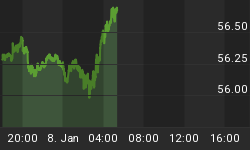Many people would consider a drop in the S&P 500 to the 1550-1600 area to be a bad thing. But if the bull is real, and if a secular bull market truly has been created out of manipulation of the T bond market (QE's bond buying and ZIRP's 0% rates) then a pullback to test that zone would be normal, would it not? It would feel bad but in reality a successful test of the big breakout would launch the grand new bull. SPX has to drop down to test support sooner or later, doesn't it?
Well no, it doesn't because the other side of the coin in the post's title is 'When Good is Bad', meaning that an upside blow off in markets - if that is what is fomenting - would be very bad, as in 'Silver 2011' bad, for the stock market with a successful test of support unlikely. That is because a manic blow off would be a terminal event.
A bearish 2014 could theoretically be a clean out and precursor to a secular bull. In short, a near term bear case is what the market needs to put a scare into 'em; a scare the likes of which has not been experienced by today's brave bulls (these were the same people hiding under rocks in 2009 when it was time to get bullish) since the now-massive 5th wave of the cycle out of 2009 got going in 2011.
Alternatively, a 'do not pass go, do not collect $200' sort of direct upside acceleration here would send the stock market to a jail of its own making. That would take the form of a blow off and exhaustion, from which it would not come back any time soon.
Once again we turn to our friends at SlopeCharts for some truthful data points that the one-way perma bulls now touting the great Bernanke recovery can't or won't acknowledge. We use the Dow instead of the usual S&P 500 chart due to its very long term history of data to show just how distorted the US financial markets have become.
The chart below uses the headline stock index (Dow) that most Americans think of as 'the stock market' and the T Bill yield, that most Americans, outside of the nearly extinct class known as savers (we're not talking about bonds here folks; those are not savings) don't even know exists and if they do, don't give a damned about.
The Dow feeds off of monetary policy by this, and so many other data sets I could show you. A bulls' answer might be 'yeh but look how low the T Bill yield was in the 1950s smart ass', to which I'd answer 'as it should have been for the safest monetary vehicle of a net creditor nation that had much of its Treasury backed by gold'. Again, we are talking facts here, not fantasy. If you see me spewing something wrong headed, drop me a civil note about it and we'll discuss it.

But again please dear Fed sycophants (AKA those financial advisers, asset managers and media directly benefiting from an always bullish stance), you be honest too. The stock market has risen in tandem with a great inflationary operation that has in one form or another been ongoing since Alan Greenspan began drinking and later guzzling at the wellspring left him by Paul Volcker roughly at the peak of the green line (3 month T Bill yield) on the chart above, at about 16%.
You notice that the last two times the T Bill yield spiked the Dow soon did too; in the opposite direction prompting near-zero and zero Fed Funds policy by Greenspan and Bernanke, respectively, early last decade and in 2008.
So please perma-bulls, spare us the crap about how Bernanke saved the financial system. This ridiculous statement has shown up in the media, in online forums and across the social networks with regularity, often in response to my articles critical of "The Hero".
He saved it from what, Greenspan's policy mistakes? Well okay, Bernanke has done the same thing as Greenspan in manipulating credit and building distortions (again, behold the Dow's structure above and its utter dependence upon a ZIRP'ed T Bill rate, which has been scuttling along the floor for well over 5 years now). The chart does not lie, but many perma-bulls do; they lie to themselves if they see something sustainable here.
So we bring it back around to the first part of the post's title, 'when bad is good'. Lately, it is looking more like an upside acceleration is coming into play for markets that have been hooked up to a non-stop ZIRP spigot for over a half a decade. If that happens, it will be terminal because manic blow offs always are. Further, there would be no corn left over at Policy Central to feed (support) the bloated pig.
So prudent investors might hope that 'bad' comes about soon, and that it proves to be 'good' by holding the big picture breakout support. Most wouldn't hope for that, however. They'd get lost in the euphoria and in their own hubris just like they got lost in their own fear and agony in 2008.
So to conclude and speaking for myself, I am going to play whatever this market is. But I did not write this post as an exercise. I am going to use its general thesis as a guide and work hard each and every week to fill in the details for NFTRH subscribers, on the US market and indeed, a world full of assets and markets in motion right now. Bull or bear, bad or good, and... the other way around.![]()

















